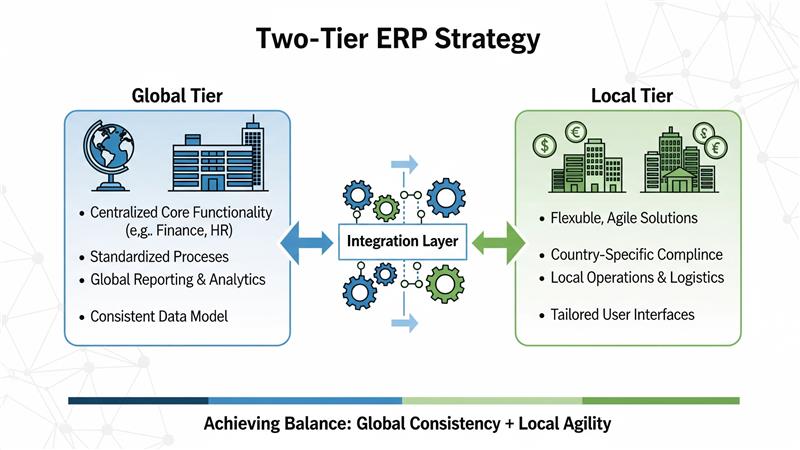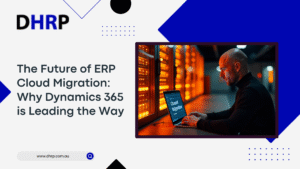No business is just local anymore; every organisation is embracing global efficiency. But expanding globally can be exhausting not only for the resources, but also for operations. However, to address the issue, a two-tier ERP strategy is gaining more attention.
But can it help in balancing the global and local needs of any business? The short answer is yes. As for the long answer, we first need to understand the 2-tier ERP strategy and how an experienced ERP consultant can guide organisations in implementing it effectively.
So, let’s talk about it.
What is Two-Tier ERP?

The term “two-tier ERP” describes a method by which a business divides its ERP system, which consists of:
- The first system serves as the organisation’s solid base.
- The second tier comprises separate, often interconnected ERP systems that oversee the day-to-day activities of specific locations or subsidiaries.
While tier 2 solutions handle specialised or industry-specific needs, tier 1 ERP manages core business operations like finance, compliance, and human resources.
A two-tier ERP system offers more flexibility and adaptability than a conventional single-tier ERP system, which imposes a uniform system across all entities.
Numerous international organisations use this method to increase business agility and operational efficiency.
Global vs Local ERP Implementation: Finding the Sweet Spot

Under Australia’s regional requirements, centralised, one-size-fits-all rollouts frequently stall (e.g., payroll awards, eInvoicing, data residency expectations).
It is not necessary to choose between local and global ERP implementation; frontline teams can make local iterations on pricing, warehousing, or service models while maintaining group processes.
A two-tier design reduces network-wide change-management fatigue and prevents monolithic upgrades for every local adjustment, while also optimising ERP implementation costs by avoiding unnecessary system overhauls.
How to Balance Corporate and Subsidiary ERP Systems
This might be the major question on the minds of your developers and executives. So, here is your way through it:
- Balance Centralisation/Localisation: Finance control, audit trails, and master data should be centralised; logistics, taxes, and customer service should be localised.
- Guardrails Over Gatekeeping: Allow sandboxes for local experimentation while approving changes through the corporate design authority.
- Measure What Matters: Keep track of cycle times for integration health, close procedures, and new entity setup; report them alongside financial KPIs.
- Lifecycle & Exit Plans: By containerising local customisations and maintaining clean interfaces, you can make it simple to divest or onboard entities.
What are the Use Cases for Two-tier ERP?
With two-tier ERP, big businesses use a central, all-inclusive ERP system (Tier 1) for their main office and more flexible, economical ERP solutions (Tier 2) for subsidiaries, regional offices, or separate business units.
This arrangement provides subsidiaries with the flexibility to adapt to specific local or business requirements, while maintaining central oversight and data consolidation.
The following are examples of common 2-tier ERP solutions for Australian businesses:
- Subsidiaries have a different or targeted core function or sell to a different market than the parent company.
- Local business divisions require localisation because they are based in a different nation.
- To upgrade ERP to the tier 1 system used by the company's headquarters, acquired companies would need to undertake an expensive implementation, which is not justifiable.
- Enterprise sites require extensive functionality to satisfy their unique requirements, which may be related to manufacturing, supply chain management (SCM), or another specialised focus.
- The company wants to modernise in some ways by implementing some new software, like SaaS ERP, but it still wants to maintain the legacy system.
- Several ERP systems may be in place at businesses that have merged or acquired, and these systems must be integrated. The larger, more complete ERP system utilised at the corporate or headquarters level can be integrated with the aid of a two-tier ERP strategy.
- Businesses that are keeping an eye on their expenditures may discover that a two-tier ERP approach is more economical than setting up a single, all-inclusive ERP system for every location.
Why Microsoft Dynamics 365 Fits a Two-Tier Model for Australia
You may have many ERP options to consider, but many experts advise you to migrate Dynamics AX to Dynamics 365 or to implement it. Why?
- Clear Tiering: Many organisations use Dynamics 365 Business Central for subsidiaries (Tier 2) and Dynamics 365 Finance & Supply Chain Management for headquarters (Tier 1), then integrate for intercompany and group reporting. This model is well-documented in recent industry guidance and has reached maturity within the Microsoft ecosystem.
- Data Residency & Compliance: Microsoft offers Dynamics 365 and Power Platform services in-region, meeting the data residency requirements of Australian tenants in its Australia East (NSW) and Australia South-east (VIC) regions.
- Cloud-Native Resilience: While keeping apps close to users, Azure's geo-redundant infrastructure and regional geographies help meet performance, sovereignty, and continuity expectations.
These features support the Dynamics 365 ERP cloud benefits for Australian businesses seeking evergreen updates, quicker deployments, and reduced infrastructure overhead compared to on-premises options.
Benefits of Two-Tier ERP Strategy
Four main factors contribute to the popularity of two-tier ERPs. Even though they use different systems in different regions, they centralize information management in one location. While still integrating with the main ERP at headquarters, they give each office the freedom to select the system that best suits their area.
They are also typically far less expensive than utilizing several large-scale ERPs. Lastly, they make the mergers and acquisitions (M&A) process simpler.
In short, the following are the main Two-Tier ERP strategy benefits:
- Cost Efficiency: Uses smaller, more cost-effective solutions at the subsidiary level to cut down on the overhead of managing an extensive, customised ERP system across all business units.
- Faster Implementation: Allows for a faster time-to-value and facilitates the deployment of new systems, which is particularly advantageous when integrating acquired businesses or creating new business units.
- Operational Flexibility: Permits the use of ERP systems by subsidiaries that are customised to meet their unique operational requirements, local market demands, and legal requirements.
- Centralised Reporting: Guarantees that the parent company's structured integration of data from both tiers maintains a unified, enterprise-wide view of financial and operational performance.
- Empowered Subsidiaries: Enable subsidiaries to maintain corporate standards while maintaining independence and control over their local operations.
- Improved User Experience: Frequently offers a simpler and easier-to-use interface at the subsidiary level, which can enhance productivity and reduce training expenses.
- Reduced Risk: A two-tiered, phased implementation strategy is less risky and disruptive than a complete ERP rollout or replacement for the entire company.
- Simplified Mergers and Acquisitions (M&A): Avoids the need for a complete migration onto the corporate ERP, which simplifies the integration process for new acquisitions.
Further streamlining international M&A scenarios is Two-Tier ERP’s ability to support multiple languages and currencies.
Conclusion
Adopting a two-tier ERP strategy empowers businesses to strike the perfect balance between global efficiency and local agility. By following Two-Tier ERP deployment best practices, organisations can simplify operations, optimise costs, and reduce risks while still supporting unique subsidiary needs.
Microsoft Dynamics 365 further strengthens this model with its flexibility, compliance, and cloud-native infrastructure—ideal for Australian businesses.
At DHRP, we specialise in guiding enterprises through ERP implementations, providing Dynamics 365 implementation services and ensuring seamless integration of headquarters and subsidiary systems.
With our expertise, your organisation can achieve greater operational resilience and unlock long-term value through a carefully designed two-tier ERP approach.
FAQs
A two-tier ERP strategy supports global efficiency while enabling subsidiaries to adapt to local requirements. It improves cost savings, speeds implementation, and simplifies reporting, making it a scalable and practical approach for multinational businesses.
Two-tier ERP balances needs by centralising financial and compliance processes globally while allowing subsidiaries flexibility in local functions like taxes, logistics, and customer service. This dual approach enhances agility without sacrificing group-wide visibility or control.
Microsoft Dynamics 365 supports clear tiering, integrates subsidiaries with headquarters, and meets regional compliance. Its cloud-based structure ensures resilience, faster updates, and localised adaptability, making it a strong choice for two-tier ERP implementation worldwide.




































































































